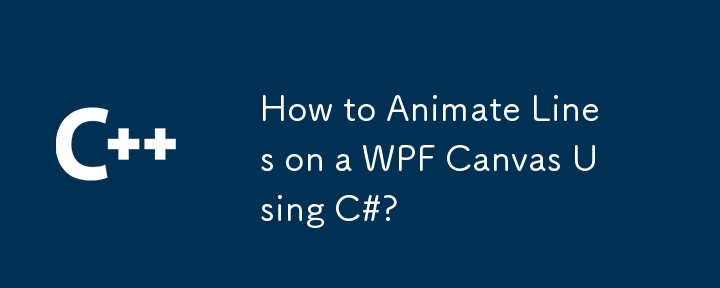How to Animate Lines on a WPF Canvas Using C#?

How to Create Animated Lines on a Canvas in C#
In a C#/WPF project, you can animate lines on a canvas by using system timers to update the line coordinates periodically.
To achieve this:
- Define a LineViewModel class that implements the INotifyPropertyChanged interface. This class will hold the line's coordinates, animation speed, and other properties.
- Create a ListBox with a Canvas as its ItemsPanel. Each item in the ListBox will represent a line.
- In the ListBox.ItemContainerStyle, define a ControlTemplate for the ListBoxItem. This template will include a Line element with its X1, Y1, X2, Y2, Thickness, Stroke, and Opacity properties bound to the corresponding properties in the LineViewModel.
- Initialize the LineViewModel with suitable initial coordinates and other properties. Add it as the DataContext for the ListBoxItem.
- Use a Timer within the LineViewModel to periodically adjust the X1, Y1, X2, and Y2 properties, effectively animating the line's position on the canvas.
- Provide controls to allow the user to adjust the animation speed. This can be achieved by modifying the AnimationSpeed property in the LineViewModel, which in turn affects the timer's interval.
- Bind the Animate property in the LineViewModel to a ToggleButton to toggle the animation on/off.
By implementing these steps, you can create an interactive animation where lines move across the canvas in a controlled and customizable manner.
The above is the detailed content of How to Animate Lines on a WPF Canvas Using C#?. For more information, please follow other related articles on the PHP Chinese website!

Hot AI Tools

Undresser.AI Undress
AI-powered app for creating realistic nude photos

AI Clothes Remover
Online AI tool for removing clothes from photos.

Undress AI Tool
Undress images for free

Clothoff.io
AI clothes remover

AI Hentai Generator
Generate AI Hentai for free.

Hot Article

Hot Tools

Notepad++7.3.1
Easy-to-use and free code editor

SublimeText3 Chinese version
Chinese version, very easy to use

Zend Studio 13.0.1
Powerful PHP integrated development environment

Dreamweaver CS6
Visual web development tools

SublimeText3 Mac version
God-level code editing software (SublimeText3)

Hot Topics
 What are the types of values returned by c language functions? What determines the return value?
Mar 03, 2025 pm 05:52 PM
What are the types of values returned by c language functions? What determines the return value?
Mar 03, 2025 pm 05:52 PM
This article details C function return types, encompassing basic (int, float, char, etc.), derived (arrays, pointers, structs), and void types. The compiler determines the return type via the function declaration and the return statement, enforcing
 Gulc: C library built from scratch
Mar 03, 2025 pm 05:46 PM
Gulc: C library built from scratch
Mar 03, 2025 pm 05:46 PM
Gulc is a high-performance C library prioritizing minimal overhead, aggressive inlining, and compiler optimization. Ideal for performance-critical applications like high-frequency trading and embedded systems, its design emphasizes simplicity, modul
 What are the definitions and calling rules of c language functions and what are the
Mar 03, 2025 pm 05:53 PM
What are the definitions and calling rules of c language functions and what are the
Mar 03, 2025 pm 05:53 PM
This article explains C function declaration vs. definition, argument passing (by value and by pointer), return values, and common pitfalls like memory leaks and type mismatches. It emphasizes the importance of declarations for modularity and provi
 C language function format letter case conversion steps
Mar 03, 2025 pm 05:53 PM
C language function format letter case conversion steps
Mar 03, 2025 pm 05:53 PM
This article details C functions for string case conversion. It explains using toupper() and tolower() from ctype.h, iterating through strings, and handling null terminators. Common pitfalls like forgetting ctype.h and modifying string literals are
 Where is the return value of the c language function stored in memory?
Mar 03, 2025 pm 05:51 PM
Where is the return value of the c language function stored in memory?
Mar 03, 2025 pm 05:51 PM
This article examines C function return value storage. Small return values are typically stored in registers for speed; larger values may use pointers to memory (stack or heap), impacting lifetime and requiring manual memory management. Directly acc
 distinct usage and phrase sharing
Mar 03, 2025 pm 05:51 PM
distinct usage and phrase sharing
Mar 03, 2025 pm 05:51 PM
This article analyzes the multifaceted uses of the adjective "distinct," exploring its grammatical functions, common phrases (e.g., "distinct from," "distinctly different"), and nuanced application in formal vs. informal
 How does the C Standard Template Library (STL) work?
Mar 12, 2025 pm 04:50 PM
How does the C Standard Template Library (STL) work?
Mar 12, 2025 pm 04:50 PM
This article explains the C Standard Template Library (STL), focusing on its core components: containers, iterators, algorithms, and functors. It details how these interact to enable generic programming, improving code efficiency and readability t
 How do I use algorithms from the STL (sort, find, transform, etc.) efficiently?
Mar 12, 2025 pm 04:52 PM
How do I use algorithms from the STL (sort, find, transform, etc.) efficiently?
Mar 12, 2025 pm 04:52 PM
This article details efficient STL algorithm usage in C . It emphasizes data structure choice (vectors vs. lists), algorithm complexity analysis (e.g., std::sort vs. std::partial_sort), iterator usage, and parallel execution. Common pitfalls like






